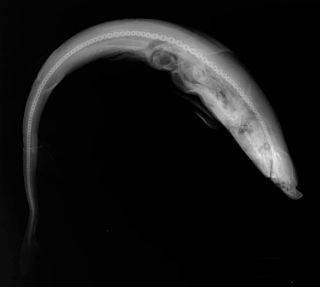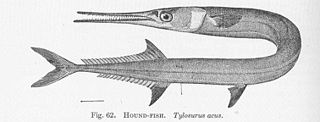
Stegastes is a genus of ray-finned fish in the family Pomacentridae. Members of this genus are marine coastal fishes except for S. otophorus, which also occurs in brackish water. These fish are known by the names of damselfish, gregory and major. They are small tropical fish associated with coral and rocky reefs in the Atlantic, Indian and Pacific Oceans. They are sometimes found in the aquarium trade where they are an easy-to-keep fish, but they do not mix well with other fish of their own or other species because of their territorial habits and aggressiveness.

The Atlantic weasel shark is a weasel shark of the family Hemigaleidae, found in the eastern Atlantic Ocean. Also known as the little tiger shark, it is the only species of the genus Paragaleus to have been recorded off the western coast of Africa. It is one of four species of small sharks within the carcharhinoid genus Paragaleus, including Paragaleus leucolomatus, Paragaleus tengi, and Paragaleus randalli. It also one of eight species within the weasel shark family, Hemigaleidae. It is currently considered by the International Union for Conservation of Nature (IUCN) as data deficient due to lack of availability of specific information on catches and population trends of the species.

The round scad is a species of fish in the Carangidae. It was described in 1829 by the French naturalist and zoologist, Georges Cuvier. Although the round scad is considered a good food fish, it is mostly caught for use as bait.

Stegastes adustus, the dusky damselfish or scarlet-backed demoiselle, is a damselfish of the family Pomacentridae found at one- to three-meter depths on surging and wavy coral reefs in the Caribbean Sea, the tropical waters of the western Atlantic Ocean, and the Gulf of Mexico.

Stegastes leucostictus is a species of damselfish found near the sea bed in shallow waters on the western fringes of the Atlantic Ocean. It is commonly known as the beau gregory or beaugregory.

The Atlantic trumpetfish, Aulostomus strigosus is a species of trumpetfish in the family Aulostomidae. It is a tropical marine fish found in shallow coastal waters in the eastern Atlantic Ocean from Mauritania to Namibia. Like other trumpetfish, they eat mainly small fish and often shadow other piscivores while hunting.

The dwarf wrasse, Doratonotus megalepis, is a species of wrasse native to tropical waters of the western Atlantic Ocean from Florida, United States, to Brazil and in the eastern Atlantic from around Ile Las Rolas, São Tomé and the Cape Verde Islands. It is found in beds of turtle grass at depths of 1 to 15 m, where its green coloration allows it to blend in with its surroundings. This species grows to a total length of 9.4 cm (3.7 in). It can be found in the aquarium trade. This species is the only known member of its genus.

Stegastes leucorus, commonly known as the whitetail damselfish, the whitetail gregory or the whitetail major, is a damselfish of the family Pomacentridae. It is native to the tropical eastern Pacific Ocean.
Stegastes acapulcoensis, commonly called the Acapulco major, the Acapulco damselfish, or the Acapulco gregory, is a species of damselfish of the family Pomacentridae. It is native to the eastern Pacific Ocean.

Stegastes arcifrons, the island major or Galapagos gregory, is a damselfish of the family Pomacentridae native to the eastern Pacific Ocean. Its range extendins from Costa Rica to the Cocos Islands, Malpelo Island, and the Galapagos Islands. It is found on rocky and coral reefs at depths ranging from 1 to 20 m. It is common in many parts of its range, and its population appears to be stable. No particular threats have been identified, and the IUCN rates it as being of "Least Concern".

Stegastes aureus, the golden gregory, is a damselfish of the family Pomacentridae native to islands in the tropical Pacific Ocean, its range including New Caledonia, the Gilbert Islands, Line Island, Phoenix Island, Samoa, the Tuamotu Archipelago, and the Marquesas Islands. It is found on coral reefs at depths ranging from 1 to 5 m.

Stegastes rectifraenum, commonly known as the Cortez damselfish or Cortez gregory, is a damselfish of the family Pomacentridae. It is native to the tropical eastern Pacific Ocean, its range including Baja California in Mexico, and the Gulf of California. It is found on rocky inshore reefs at depths ranging from 1 to 10 m.

Stegastes flavilatus, commonly known as beaubrummel, is a damselfish of the family Pomacentridae. It is native to the tropical eastern Pacific Ocean, its range extends from Mexico, Baja California and the Gulf of California southwards to the Galapagos Islands and mainland Ecuador. It is found on rocky inshore reefs at depths ranging from 1 to 10 m.

Stegastes redemptus, commonly known as the clarion major, clarion damselfish or clarion gregory, is a damselfish of the family Pomacentridae. It is native to the tropical eastern Pacific Ocean, its range extending from the Revillagigedo Islands to the coast of Baja California. It is found on rocky reefs at depths ranging from 1 to 15 m.

Paroncheilus affinis, the bigtooth cardinalfish or longtooth cardinalfish, is a species of marine fish in the family Apogonidae and the only member of its genus. The bigtooth cardinalfish lives in the west-central Atlantic, off southern Florida, United States, and from the Bahamas to Venezuela, and as far south as Suriname. This species also is found in the east-central Atlantic and the Gulf of Guinea, and has been reported as far as Cape Verde. It is a pale orangeish colour.

The Canary damsel is a species of marine fish of the family Pomacentridae. It lives primary in shallow, subtropical waters of the Atlantic Ocean, and is sometimes also known as the Cape Verde gregory, which is also a common name of Stegastes imbricatus.
Chelon bispinosus is a fish of the family Mugilidae. It is one of seven species in the genus Chelon. It is endemic to waters near Cape Verde in the east central Atlantic Ocean. This species is found in the neritic zone.
Dagetichthys lusitanicus, commonly known as the Portuguese sole, is a species of flatfish native to the eastern Atlantic Ocean. Little is known of the abundance or behaviour of this fish, and the International Union for Conservation of Nature has rated its conservation status as being "data deficient".

Tylosurus acus is a game fish of the family Belonidae.

Semicossyphus darwini is a species of ray-finned fish native to the tropical eastern Pacific Ocean. Common names include the Chilean sheepshead wrasse, the goldspot sheepshead or the Galapagos sheepshead wrasse.


















